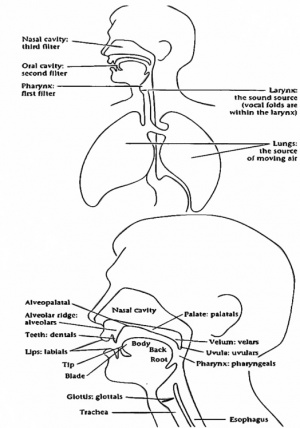Difference between revisions of "Language/Multiple-languages/Pronunciation/International-Phonetic-Alphabet"
m (Quick edit) |
|||
| (39 intermediate revisions by 2 users not shown) | |||
| Line 1: | Line 1: | ||
When I learn a language, the books always show a similar | [[File:sounds-body.jpg|thumb]] | ||
When I learn a language, the books always show a similar phoneme in the learner's known language to tell how to pronounce a phoneme. But that's really not an appropriate method for a language enthusiast, because that is the reason why people pronounce in the target language like in their native language. So it's necessary to learn IPA. After mastering the International Phonetic Alphabet in this lesson, you can also explore other related topics such as [[Language/Multiple-languages/Grammar/Common-Mistakes|common grammar mistakes]] in multiple languages and [[Language/Multiple-languages/Culture/How-to-use-SR-and-TTS-on-Windows|how to use speech recognition and text-to-speech on Windows]] for a more immersive language learning experience. 🌍🎓 | |||
__TOC__ | |||
==Resources== | |||
https://www.internationalphoneticassociation.org/ | * Official website: https://www.internationalphoneticassociation.org/ | ||
* Anki deck: https://ankiweb.net/shared/info/81778780 | |||
* Wikipedia help: https://en.wikipedia.org/wiki/Help:IPA | |||
== FAQ == | |||
=== What's the difference between voiceless and voiced? === | |||
It is whether the vocal cord is vibrating or not when pronouncing the consonant. It's hard to distinguish for a beginner. | |||
<youtube>495LciokKag</youtube> | |||
=== Why is the vowel chart shown in trapezoidal shape? === | |||
Because It resembles the oral cavity's shape facing left and for acoustic reasons, the upper part's frequencies are broader than lower part's. | |||
== | |||
https://linguistics.stackexchange.com/questions/31455/why-is-vowel-phonology-represented-in-a-trapezoid-instead-of-a-square | |||
=== | === Can I just note roughly and without so many details? === | ||
Yes. There are two sets of transcriptions: broad and narrow. If you want to give an idea on how to pronounce roughly, then broad transcription suits that. If you want to note as many details as you can, then narrow transcription. | |||
=== | === Are phonemes in “phonemic symbols for English” identical with their correspondents in IPA? === | ||
No. In English, there is no standard set of symbols. If you look up different dictionaries, you can find that they are different. Another factor can add to this complexity: there is no standard language for English, so different dictionaries adopt different dialects. | |||
Wiktionary is using the IPA, as far as I know. | |||
=== How to pronounce trills (e.g. rolling R)? === | |||
It requires patience if none of them are in your mother tongue. Just practise, no other way. If you can pronounce a type of trill, you can pronounce another type easier. If you can't succeed anyway, you may consider visiting an oral surgeon. | |||
Guidance: | |||
[[ | https://www.supercocoapp.com/post/how-to-roll-your-rs/ | ||
[[File:Greybeard.jpg|thumb|none]] | |||
<span links></span> | |||
Latest revision as of 13:36, 25 March 2023
When I learn a language, the books always show a similar phoneme in the learner's known language to tell how to pronounce a phoneme. But that's really not an appropriate method for a language enthusiast, because that is the reason why people pronounce in the target language like in their native language. So it's necessary to learn IPA. After mastering the International Phonetic Alphabet in this lesson, you can also explore other related topics such as common grammar mistakes in multiple languages and how to use speech recognition and text-to-speech on Windows for a more immersive language learning experience. 🌍🎓
Resources[edit | edit source]
- Official website: https://www.internationalphoneticassociation.org/
- Anki deck: https://ankiweb.net/shared/info/81778780
- Wikipedia help: https://en.wikipedia.org/wiki/Help:IPA
FAQ[edit | edit source]
What's the difference between voiceless and voiced?[edit | edit source]
It is whether the vocal cord is vibrating or not when pronouncing the consonant. It's hard to distinguish for a beginner.
Why is the vowel chart shown in trapezoidal shape?[edit | edit source]
Because It resembles the oral cavity's shape facing left and for acoustic reasons, the upper part's frequencies are broader than lower part's.
Can I just note roughly and without so many details?[edit | edit source]
Yes. There are two sets of transcriptions: broad and narrow. If you want to give an idea on how to pronounce roughly, then broad transcription suits that. If you want to note as many details as you can, then narrow transcription.
Are phonemes in “phonemic symbols for English” identical with their correspondents in IPA?[edit | edit source]
No. In English, there is no standard set of symbols. If you look up different dictionaries, you can find that they are different. Another factor can add to this complexity: there is no standard language for English, so different dictionaries adopt different dialects.
Wiktionary is using the IPA, as far as I know.
How to pronounce trills (e.g. rolling R)?[edit | edit source]
It requires patience if none of them are in your mother tongue. Just practise, no other way. If you can pronounce a type of trill, you can pronounce another type easier. If you can't succeed anyway, you may consider visiting an oral surgeon.
Guidance:
https://www.supercocoapp.com/post/how-to-roll-your-rs/

